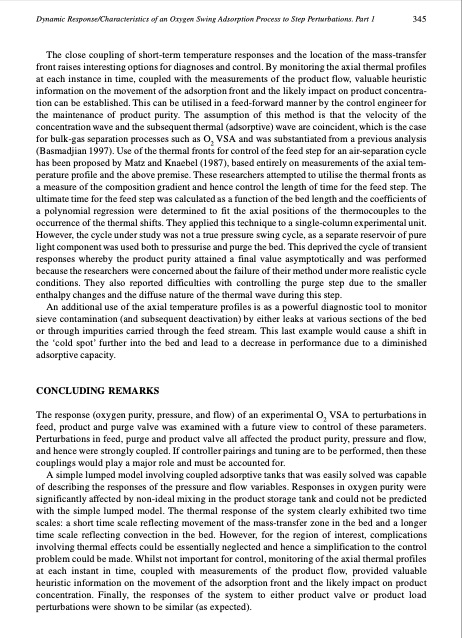
PDF Publication Title:
Text from PDF Page: 027
Dynamic Response/Characteristics of an Oxygen Swing Adsorption Process to Step Perturbations. Part 1 345 The close coupling of short-term temperature responses and the location of the mass-transfer front raises interesting options for diagnoses and control. By monitoring the axial thermal profiles at each instance in time, coupled with the measurements of the product flow, valuable heuristic information on the movement of the adsorption front and the likely impact on product concentra- tion can be established. This can be utilised in a feed-forward manner by the control engineer for the maintenance of product purity. The assumption of this method is that the velocity of the concentration wave and the subsequent thermal (adsorptive) wave are coincident, which is the case for bulk-gas separation processes such as O2 VSA and was substantiated from a previous analysis (Basmadjian 1997). Use of the thermal fronts for control of the feed step for an air-separation cycle has been proposed by Matz and Knaebel (1987), based entirely on measurements of the axial tem- perature profile and the above premise. These researchers attempted to utilise the thermal fronts as a measure of the composition gradient and hence control the length of time for the feed step. The ultimate time for the feed step was calculated as a function of the bed length and the coefficients of a polynomial regression were determined to fit the axial positions of the thermocouples to the occurrence of the thermal shifts. They applied this technique to a single-column experimental unit. However, the cycle under study was not a true pressure swing cycle, as a separate reservoir of pure light component was used both to pressurise and purge the bed. This deprived the cycle of transient responses whereby the product purity attained a final value asymptotically and was performed because the researchers were concerned about the failure of their method under more realistic cycle conditions. They also reported difficulties with controlling the purge step due to the smaller enthalpy changes and the diffuse nature of the thermal wave during this step. An additional use of the axial temperature profiles is as a powerful diagnostic tool to monitor sieve contamination (and subsequent deactivation) by either leaks at various sections of the bed or through impurities carried through the feed stream. This last example would cause a shift in the ‘cold spot’ further into the bed and lead to a decrease in performance due to a diminished adsorptive capacity. CONCLUDING REMARKS The response (oxygen purity, pressure, and flow) of an experimental O2 VSA to perturbations in feed, product and purge valve was examined with a future view to control of these parameters. Perturbations in feed, purge and product valve all affected the product purity, pressure and flow, and hence were strongly coupled. If controller pairings and tuning are to be performed, then these couplings would play a major role and must be accounted for. A simple lumped model involving coupled adsorptive tanks that was easily solved was capable of describing the responses of the pressure and flow variables. Responses in oxygen purity were significantly affected by non-ideal mixing in the product storage tank and could not be predicted with the simple lumped model. The thermal response of the system clearly exhibited two time scales: a short time scale reflecting movement of the mass-transfer zone in the bed and a longer time scale reflecting convection in the bed. However, for the region of interest, complications involving thermal effects could be essentially neglected and hence a simplification to the control problem could be made. Whilst not important for control, monitoring of the axial thermal profiles at each instant in time, coupled with measurements of the product flow, provided valuable heuristic information on the movement of the adsorption front and the likely impact on product concentration. Finally, the responses of the system to either product valve or product load perturbations were shown to be similar (as expected).PDF Image | Dynamic Response and Characteristics of an Oxygen Vacuum Swing Adsorption

PDF Search Title:
Dynamic Response and Characteristics of an Oxygen Vacuum Swing AdsorptionOriginal File Name Searched:
026361703322405051.pdfDIY PDF Search: Google It | Yahoo | Bing
CO2 Organic Rankine Cycle Experimenter Platform The supercritical CO2 phase change system is both a heat pump and organic rankine cycle which can be used for those purposes and as a supercritical extractor for advanced subcritical and supercritical extraction technology. Uses include producing nanoparticles, precious metal CO2 extraction, lithium battery recycling, and other applications... More Info
Heat Pumps CO2 ORC Heat Pump System Platform More Info
| CONTACT TEL: 608-238-6001 Email: greg@infinityturbine.com | RSS | AMP |